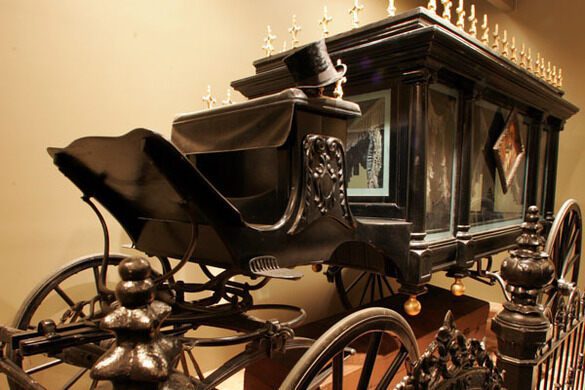
Morristown New Jersey’s World War I Memorial Cenotaph derived from the Greek term for “Empty Tomb”
The World Wars era changed American’s lives both socio-politically, economically, and culturally. Courses centering around mass conflict, war, and its implications, generally give the numbers of casualties during war in a way somewhat divorced from the impact of death itself. Allan Winkler noted that the world wars, WWII in particular, changed American life and politics in profound ways, extending power to the Executive Branch and Presidency, unprecedented to that point.[1] Still, many scholars neglect the impacts of death, the changes in our ritualized funerary practices, and our ability to be comforted by a “Beautiful Death,” as the Victorians strived to achieve. Death often brings us into a state of war, forcing our hand with the desire to avenge the wronged, spreading the American way of democracy. We see the impacts of men leaving for war on the homefront, but relatively little regarding the impacts of those very same men never returning home. Americans have become divorced from death in many ways since the rise of funeral homes, despite the importance of death rituals to the ultimate creation of culture.[2] However, studying this somewhat scary or taboo subject closer leads to a greater appreciation of the impact of death and the act of dying. Through an unbiased and full appreciation of death we reconsider war’s validity, value the lives of those lost, and inform our collective memory.
Allan Winkler states, “War, by its very nature, has always been a catalyst for change.”[3] The impact of mass death often galvanizes us to go to war, such instances have occurred throughout history, the Lusitania, Pearl Harbor, and the World Trade Towers are merely a few. When anthropologists examine the beginnings of culture, it starts with the first instances of ritualization or memorialization of the dead; through death, we create our culture; therefore, its impact is profound, according to Jack Goody.[4] Military personnel went off to war, many dying far from home without the benefit of loved ones near. Those left behind grieving did not know where their fallen soldiers’ final resting places were and travel to overseas battlefields was expensive; the separation created profound grief in Americans that droves the way we developed our collective war memory. Memorials, therefore, are so much more to the bereaved than merely a site of death. Memorials are sacred places of reverence for the fallen, a specific place where families can have a personal moment of ritualized funerary practice or share in a collective moment of grief and remembrance.
There are two ways in which culture is directly impacted by death, through our relationship to the act of dying and then our reaction to the finality of death itself, the ritual of dying and death are endemic of culture worldwide.[5] Nevertheless, we all have slightly different ways in which we memorialize our fallen soldiers. According to Jay Winter, “war memorials invite us to recall more than the central facts of loss of life and bereavement in the Great War.”[6] They also inform our collective memory regarding wars, Pearl Harbor, for instance, is a somber memorial reflecting on the idylls of World War II’s commonly accepted history; it is a place to relate to the events of the past and honor the lost. Dr. Winter believes war memorials function as funerary sites rich in iconography and various “rhetoric” of war. Memorials’ central axis, no matter how “muted,” is that war brings death on a massive scale forever changing culture.[7] War memorials help the bereaved grieve both “individually and collectively” in ways that help shape our relationship to war and death.[8] George Mosse feels that war creates “a mass encounter with death” integral to the “most basic of war experiences” for thousands of soldiers going to war at the orders of “government-sanctioned mass murder” and its historical impacts.[9]

- [1] Allan M. Winkler, Home Front U.S.A.: America During World War II, 3rd ed. (Wheeling: Harlan Davidson, Inc., 2012) Introduction.
- [2] Jack Goody, Death and the Interpretation of Culture: A Bibliographic Overview, in Death in America. (University of Pennsylvania Press, 1974), http://www.jstor.org/stable/j.ctv4rfrts, 448.
- [3] Allan M. Winkler, Home Front U.S.A.: America During World War II, 3rd ed. (Wheeling: Harlan Davidson, Inc., 2012), 115.
- [4] Jack Goody, Death and the Interpretation of Culture: A Bibliographic Overview, in Death in America. (University of Pennsylvania Press, 1974), http://www.jstor.org/stable/j.ctv4rfrts, 448.
- [5] Jack Goody, Death and the Interpretation of Culture: A Bibliographic Overview, in Death in America. (University of Pennsylvania Press, 1974), http://www.jstor.org/stable/j.ctv4rfrts, 448.
- [6] Jay M. Winter, “Spiritualism and the ‘Lost Generation’,” Sites of Memory, Sites of Mourning: The Great War in European Cultural History, (Cambridge: Cambridge University Press. 2014).
- [7] Jay M. Winter, “Spiritualism and the ‘Lost Generation’,” Sites of Memory, Sites of Mourning: The Great War in European Cultural History, (Cambridge: Cambridge University Press. 2014), 78.
- [8] Jay M. Winter, “Spiritualism and the ‘Lost Generation’,” Sites of Memory, Sites of Mourning: The Great War in European Cultural History, (Cambridge: Cambridge University Press. 2014), 79.
- [9] George L. Mosse, Fallen Soldiers: Reshaping the Memory of the World Wars (New York: Oxford University Press. 2011) 3.
- [10] Jay M. Winter, “Spiritualism and the ‘Lost Generation’,” Sites of Memory, Sites of Mourning: The Great War in European Cultural History, (Cambridge: Cambridge University Press. 2014).
- [11] George L. Mosse, Fallen Soldiers: Reshaping the Memory of the World Wars (New York: Oxford University Press. 2011).
- [12] Jack Goody, Death and the Interpretation of Culture: A Bibliographic Overview, in Death in America. (University of Pennsylvania Press, 1974), http://www.jstor.org/stable/j.ctv4rfrts, 455.
References
Lears, T. J. Jackson, “Rebirth of a Nation: The Making of Modern America, 1877-1920,” New York: Harper Perennial, 2010.
Turner, Frederick Jackson, and John Mack Faragher. Rereading Frederick Jackson Turner: “The Significance of the Frontier in American History” and Other Essays. Yale University Press, 1994. http://www.jstor.org/stable/j.ctt32bv5g.
Adams, David Wallace. “More than a Game: The Carlisle Indians Take to the Gridiron, 1893-1917.” The Western Historical Quarterly 32, no. 1 (2001): 25-53. doi:10.2307/3650836.
Pérez, Jr., Louis A. “Incurring a Debt of Gratitude: 1898 and the Moral Sources of United States Hegemony in Cuba.” The American Historical Review 104, no. 2 (1999): 356-98. doi:10.2307/2650370.
Santamarina, Juan C. “The Cuba Company and the Expansion of American Business in Cuba, 1898-1915.” The Business History Review 74, no. 1 (2000): 41-83. http://www.jstor.org.ezproxy.snhu.edu/stable/3116352.

